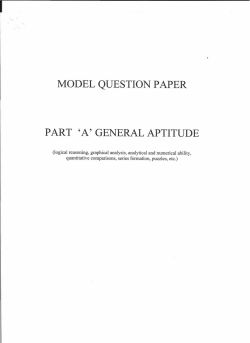
File - Mr. Quick`s Classroom
Name ________________________________________ Date __________________ Class __________________ MODULE 13 Theoretical Probability and Simulations Module Quiz: B 7. Without looking, Tammy takes a marble out of a bag that contains 10 red marbles, 15 green marbles, and 25 blue marbles. She records its color and returns the marble to the bag. If Tammy repeats this process 90 times, how many times can she expect to pull out a red marble? 1. What is the probability of flipping a coin 3 times and getting 3 heads? ________________________________________ 2. Two number cubes each have sides that are labeled 1 to 6. Isis rolls the 2 number cubes. What is the probability that the sum of the numbers rolled will equal 4? ________________________________________ ________________________________________ 8. Caelin drives at 30 miles per hour. How many hours will it take him to drive 210 miles? 3. Dustin has a spinner that is divided into 5 equal-size sections colored red, blue, orange, white, and green. What is the probability that Dustin spins pink on the next spin? ________________________________________ 9. Alexander spins a spinner with four equally-sized regions and flips a coin. How many outcomes are possible? ________________________________________ 4. Isidro flips a fair coin 40 times. How many times can he expect heads to appear? ________________________________________ 10. Scarlett selects a card at random from a deck that contains 18 red, 12 yellow, and 20 blue cards. What is the probability that she does not select a red card? ________________________________________ 5. A number cube has sides labeled 1 to 6. Hannah rolls the number cube 18 times. How many times can she expect to roll a number less than 3? ________________________________________ C green B red D orange 13 25 C 18 25 B 16 25 D 24 25 11. Bella rolls 2 number cubes 60 times. How many times can she expect the sum of the numbers to be greater than 10? 6. Flavia has a bag with 8 white balls, 9 red balls, 14 green balls, and 10 orange balls. If she chooses a ball from the bag without looking, which color ball will Flavia be least likely to choose? A white A ________________________________________ 12. Glen has 3 pairs of shoes, 5 shirts, and 4 pairs of pants. How many outfits consisting of 1 pair of shoes, 1 shirt, and 1 pair of pants can he make? ________________________________________ Original content Copyright © by Houghton Mifflin Harcourt. Additions and changes to the original content are the responsibility of the instructor. 63 Name ________________________________________ Date __________________ Class __________________ MODULE 13 Theoretical Probability and Simulations Module Quiz: B 13. Two number cubes each have sides labeled 1 to 6. Ann rolls both number cubes. On the first roll, the sum of the numbers was equal to 10. On the second roll, the sum of the numbers was equal to 7. Which sum was more likely to occur? Explain. 16. Constantine walked 4 miles in 50 minutes. If he continues walking at this pace, how many minutes will it take him to walk 6 miles? ________________________________________ 17. ________________________________________ ________________________________________ Simran’s Simulation Results Trial ________________________________________ ________________________________________ 14. Simran’s Simulation Results Trial Numbers Numbers Trial Generated Generated 1 1, 1, 3, 3 6 4, 5, 5, 5 2 3, 4, 5, 5 7 3, 4, 4, 5 3 2, 3, 4, 4 8 2, 2, 2, 1 4 1, 3, 4, 4 9 4, 5, 5, 3 5 3, 4, 4, 5 10 3, 3, 3, 3 Numbers Numbers Trial Generated Generated 1 1, 1, 3, 3 6 4, 5, 5, 5 2 3, 4, 5, 5 7 3, 4, 4, 5 3 2, 3, 4, 4 8 2, 2, 2, 1 4 1, 3, 4, 4 9 4, 5, 5, 3 5 3, 4, 4, 5 10 3, 3, 3, 3 Simran used a simulation to predict the number of days of rain in his town. A number 1 or 2 indicates a week in which it rained. Numbers 3, 4, or 5 indicate a week in which it did not rain. The results of the simulation are shown above. What is the experimental probability that it will rain in Simran’s town in at least 1 of the next 4 weeks? Simran used a simulation to predict the number of defective parts that are produced in a factory. Random numbers are generated. A number 1 indicates that the part is defective. Numbers 2, 3, 4, or 5 indicate that the part is not defective. Of the next four parts produced, what is the experimental probability that none of the parts are defective? ________________________________________ 18. Each student in a class of 25 students wrote down a random digit. What is the predicted number of students who wrote a digit that is greater than 7? ________________________________________ ________________________________________ 19. A special deck of cards consists of 5 red cards, 20 blue cards, and 25 green cards. Svetlana selects 1 card from the special deck 500 times. How many times can she expect to draw a red card? 15. Fatima bought a video game that has a regular price of $45. The game was on sale for 15 percent off, and she paid sales tax of 7 percent. What was the price Fatima paid for the video game? ________________________________________ ________________________________________ Original content Copyright © by Houghton Mifflin Harcourt. Additions and changes to the original content are the responsibility of the instructor. 64
© Copyright 2025










